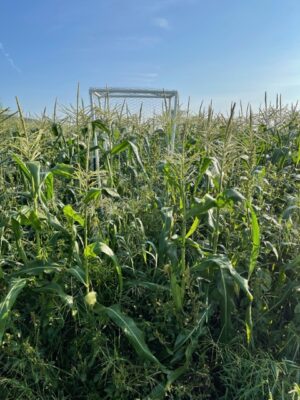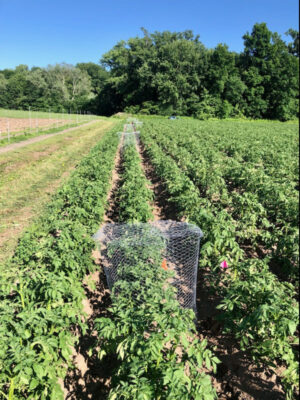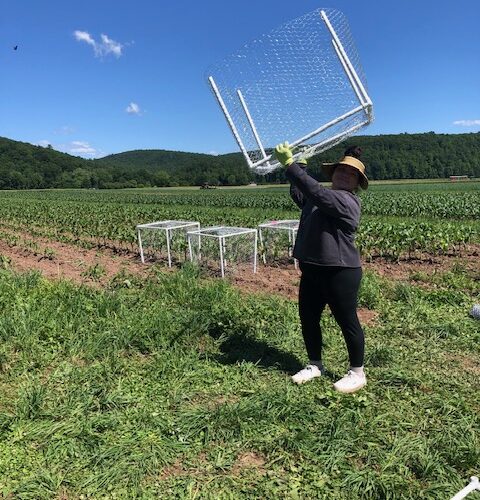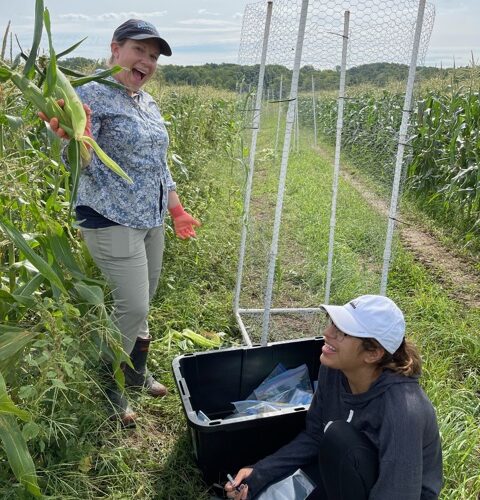A study by Columbia University researchers examines the connections between birds and farms
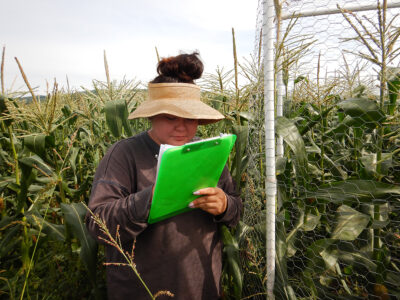
On many farms, birds are considered a nuisance as they have been known to damage crops. Scarecrows or other handmade deterrents with shiny objects, such as CDs, are a common sight on farms as they are used to discourage birds from eating seeds, shoots, and vegetables.
Dr. Sara Kross, a conservation biologist and lecturer at Columbia University, notes that farmers should consider otherwise. According to Kross, birds can provide pest control, and farms can also offer much-needed habitat for birds.
In early September, Kross and Andie Muñoz, a graduate student in Columbia’s Environmental, Evolution, and Conservation Biology program, completed a pilot research trial at the Farm Hub that examines whether birds can be beneficial to farms. The researchers documented pest insects and beneficial insects and examined their connections to crop quality and yield. Kross is a member of the Applied Farmscape Ecology Research Collaborative at the Farm Hub, a group of scientists and researchers who study the relationships between wildlife, soil microbes, water, plants, and farming.
Here’s how the study worked: in June the research team set up a series of exclosures on plots of corn, green beans, and potatoes at the Farm Hub. Farm Manager Jeff Arnold and the production team picked crops that have commonly seen the greatest pest issues on the farm. Sweet corn, for example, is often targeted by European corn borers, corn earworms, fall armyworms, and Japanese beetles with damage visible on stalks, leaves, and tips of the corn ears. Birds, however, contribute to a sizeable crop loss even here on the farm, mainly in the sweet corn and blueberries, Arnold says.
The exclosures were made out of poles and chicken wire and were placed around the vegetables.
“The idea is to see if there is a difference in the number of insects between crops that are shielded from bird activity versus crops that are exposed to bird activity,” explains Muñoz. “If there are lower numbers of pests inside of the exclosures, there may be no difference and farms can put up scarecrows, but maybe we can show birds can provide a service if we find higher numbers of pests inside the exclosures when the plants are kept from bird foraging,” Kross says.
Arnold says the research project has the potential to identify unknown benefits birds offer.
“This is a really interesting project. For many crops, birds can cause substantial yield reductions, and farmers go to great lengths to exclude them from fields. But we don’t know very much about the pest reduction services they might also be providing,” he says.
Over the past few months, Muñoz took the lead in coming to the farm every few weeks to engage in insect counts and identification. Her alarm was set for 4am, as the journey from Jamaica, Queens to the farm in Hurley takes well over two hours each way.
The researchers tracked the specific types of bird species and the beneficial and pest insects they observed; they have noted there were an ample number of Red-winged blackbirds, song- and savannah-sparrows, and Bobolinks. They also followed the flight patterns of birds within the fields and outside of the fields to identify connections with the number of insects.
The experiment was Kross’s idea: Most recently similar experiments have been done in California where researchers compare a large number of farms in one area and study the bird communities on the farm. They also analyze farming practices of each farm. In 2015, as a David H. Smith Conservation Research Postdoctoral Fellow, she ran a field research program to assess how farms in California can be made more bird-friendly, and whether bird-friendly management practices lead to better pest-control services.
“I would look at the bird communities at those farms and they usually change quite drastically depending on whether there is habitat available or not, and then I was interested in looking in turn at the ecosystem services from birds,” she says, noting it is pest control that birds provide.
After consulting with Anne Bloomfield, Applied Farmscape Ecology Program Manager, and Conrad Vispo of the Hawthorne Valley Farmscape Ecology Program, Kross decided to “flip the script to look at several crops on the same farm” because the Farm Hub has a fairly stable community of bird species. “By doing this work here, we are controlling for environmental factors and bird communities and just looking at whether a single community of birds impacts different crops in different ways,” she says.
To date, 179 bird species have been identified on the farm.
Since then, Kross and Muñoz have regularly returned to the farm to monitor the insects and signs of insect damage on the. Andie also tracks beneficial insects such as lady beetles and spiders to investigate whether birds affect the number of pests, beneficials, or both. As such, the exclosures allow the researchers to quantify the effects of foliage gleaning insectivores, which include birds.
What next?
On the last day of August, Kross and Munoz arrived in the morning to disassemble the exclosures in the cornfield. There was a moment of anticipation before they peeled back the husks of the corn inside the exclosures.
“We are hoping to find some damage so we can have a baseline to compare the bird exclosures to,” says Kross. “We are most interested in the damage to the corn ears because that is what farmers care about – the actual corn.”
Husking the corn in the field, they found a number of European corn borers and corn earworms on the corn ears. While they are still carrying out their statistical analyses, they have preliminarily found that there was a difference in pests numbers between the corn kept from bird activity and the corn exposed to bird activity. In the corn, it seems there are slightly fewer pests when corn is exposed to bird activity, which may indicate that birds are providing a service of foraging on pests. However, more analysis is needed to test whether this difference is statistically significant in the corn and whether this pattern is seen in the other two crops examined.
When Muñoz returns to campus to complete the final year of her Master’s program this fall, she will be busy crunching the data collected. She plans to use it as part of her thesis. There are also further plans to share the datasets with farmers and present the findings at the Farm Hub.
– Amy Wu

